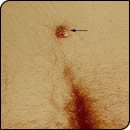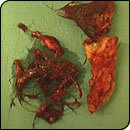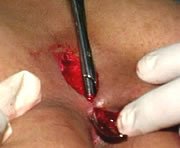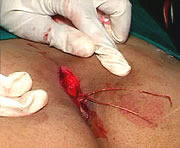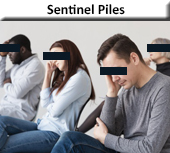Pilonidal Sinus
Pilonidal means a nest of hairs. A pilonidal sinus is a sinus that contains a tuft of hairs. These sinuses are commonly found in the skin covering the sacrum and coccyx but can occur between the fingers, particularly in barbers, and at the umbilicus.
A pilonidal sinus is not lined by skin and there are no hairs growing within it. In fact, the hairs in the sinus are short, broken pieces of hair that either get sucked into a pre-existing dimple or actually pierce the normal skin in the gluteal cleft and then, by acting as foreign bodies, aid and support the development of chronic infection. The result is a chronic abscess which contains hair and which flares up at frequent intervals into an acute abscess.
Risk Groups
The risk groups for pilonidal sinuses are :
- Dark-haired, hirsute men.
- Mens’ hairdressers; sometimes get pilonidal sinuses in the webs between the fingers.
- Farmers may develop pilonidal sinuses in their skin webs as a result of implanted hairs from farm animals.
- About 75% of pilonidal sinuses occur in men, usually from the age of puberty to about 40 years of age, but rarely in older people.
- Women who develop a pilonidal sinus tend to be younger. This is consistent with their earlier onset of puberty.
- Patients tend to be, but are not invariably, dark, hairy, and they are often obese.
- About half of patients present as acute emergencies with a pilonidal abscess.
Pathogenesis
The vast majority of pilonidal sinuses are acquired anomalies. Rarely, a congenital sinus may be associated with a dermoid cyst.
They develop at the onset of puberty. This is when sex hormones start to act on pilosebaceous glands in the natal cleft. A hair follicle becomes distended with keratin and then becomes infected. Folliculitis ensues and an abscess extends down into the subcutaneous fat. Tracks form out of the cavity in the direction of neighbouring hair growth – in over 90% of cases towards the patient’s head. Hairs are sucked or drilled into the cavity as a result of friction with the movement of the buttocks. The hairs on the barbs act to prevent expulsion. These hair then provoke a foreign body reaction and infection.
What are the symptoms ? (clinical features)
Typically the pilonidal sinus patient is male with thick black hair. The commonest age group for presentation is between 15 and 40 years.
The most common site for the pilonidal sinus is over the sacrum in the gluteal cleft. Other sites include the hands, axillae and the umbilicus.
The patient complains of recurrent episodes of pain or sepsis. There are often periods of several months between episodes. As the size of the sinus increases the frequency of painful episodes also increases.
On examination a pit is seen in the midline of the sinus. One sinus may have several pits. The hairs are visible pointing into the sinus. Pressure on the sinus may exude pus or blood from the pit(s).
How is pilonidal disease treated?
- The treatment depends on the disease pattern. An acute abscess is managed with an incision and drained to release the pus, and reduce the inflammation and pain. This procedure is performed as an emergency in hospital under general anaesthesia. The patient is discharged either on the same or following day. A chronic sinus may persist after the abscess cavity has healed and this usually needs to be excised or surgically opened.
- Complex or recurrent disease must be treated surgically. Procedures vary from unroofing the sinuses to excision (Figure 2) and possible closure with flaps. Larger operations require longer healing times. If the wound is left open, it will require dressing or packing to keep it clean. Although it may take several weeks to heal, the success rate with open wounds is higher. Closure with flaps is a bigger operation that has a higher chance of infection; however, healing and recovery is quicker. Mr Abulafi or a member of his team will discuss these options with you and help you select the appropriate operation.
(If a pilonidal sinus is small, then it may only require antibiotic treatment. If the sinus develops into an acutely inflamed abscess, then it will require drainage.)
There are three alternative procedures that may be undertaken :
- The lesion can be incised and laid open
- The lesion can be completely excised
- The lesion can be curetted and injected with phenol
Operative Steps
Anveshana (Identifying Track)
Loma Nishkasana ( Removing Hair 1)
Loma Nishkasana ( Removing Hair 2)
Prognosis
The recurrence rate of pilonidal sinuses after surgery is purported to be as high as 50%.
If recurrence occurs early, then this is generally due to the persistence of tracks line with granulation tissue in an incompletely healed wound. Late recurrence is the result of repeated infection of hair follicles. The procedures that leave a midline scar are the most susceptible to further hair penetration. If healing has occurred by secondary penetration, then this leaves a broad, flat, hairless scar that reduces buttock friction and is less susceptible to penetration by hair.
What care is required after surgery ?
If the wound can be closed, it will need to be kept clean and dry until the skin is completely healed. If the wound must be left open, dressings or packing will be needed (usually by the district or practice nurse) to help remove secretions and to allow the wound to heal from the bottom up.
After healing, the skin in the buttocks crease must be kept clean and free of hair. This is accomplished by shaving or using a hair removal agent every two or three weeks until age 30. After age 30, the hair shaft thins, becomes softer and the buttock cleft becomes less deep.
Questions to ask your doctor
- How long would you recommend I take off work?
- How long would you recommend that I need to shave the area and how large an area should I shave?
- What are the chances that the condition will recur?
- What operation do you plan and will you skew the scar off the midline if you close the wound

